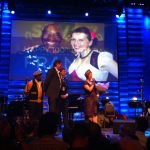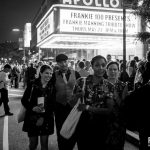I’m teaching my husband the basics of event marketing so I thought I’d also share my methodology as a blog post. It certainly pertains to event marketing for Lindy Hop events so I hope someone may find this helpful.
Part I – Set Up
1. Shared Drive
Before setting up anything else, I strongly recommend setting up a shared Drive to store all of your digital assets and administrative documents. My preference is Google Drive. Even if you’re working alone, this can act as a good back up rather than keeping it all on your computer. Put everything in there for easy access.
2. Core Event Pitch & Creatives
First, prepare your core event “elevator pitch” along with a more detailed explanation of the event. Of course, you’ll need a great name.
Consider the core FAQ information related to the event to head off any questions or confusion. Who, what, where, when, why, how.
Along with your core pitch, create your key graphical elements, aka. creatives. You’ll want to size the key graphics for your website, the Facebook event, and an Instagram square version (which also looks good on Facebook). We also needed a specific size for our event ticket system.
The horizontal Facebook event size of the image will often work as your website banner and the horizontal format can be a good option for Twitter and LinkedIn (if those are important for your marketing) without having to fuss with too many resizes.
I would also recommend having an event hashtag (“proprietary hashtag”) that you make clear in your event pitch and in all of your ensuing marketing materials. See more of this below in the Instagram section.
You might find it useful to design a vertical poster but I personally steer away from print ads and I don’t find the vertical size necessary for digital advertising, outside of Instagram Stories or TikTok, if you’re doing that. (I usually just share the square version in Instagram Stories to streamline the process. That’s not really a best practice, but sometimes simplification is important and it does the job.)
3. Website (or Central Front-of-House Location)
Once you have your event pitch sorted, the first thing to do is to update your website with all of the details. If you don’t have a website, though it’s less than ideal, you might use a Facebook event or a ticketing system as your central front-of-house location for the event details.
You might have an entire website dedicated to just the event, a page on a website, or you might create a post on your blog roll. I’d like to explain a few tricks about that.
I’ll use the example of our hobby website, Stepping Out Vintage. It’s a WordPress website, which is my preference. For that website, we’ve got it set up with the homepage as a blogroll.
What I’ve set up in this kind of scenario is that you create a post (rather than a page) for your event. There are a few advantages and approaches to how I like to set this up.
- The event will appear front and centre on the homepage, as long as it’s the newest post
- I can create an empty page with a redirect that points to the blog post so the event can also appear in the top menu
- I can create a category for all upcoming events
- I can also keep a category for all past events to keep a record of them
Let me explain #2 about the page and redirect:
The main information for this year’s event will live in a post. However, you can also set up an empty page that will redirect to the post. You can do this by adding the post directly to your menu in the Appearance > Menu options within WordPress, but I personally prefer to have a short and easy URL. You can add a Quick Page/Post Redirect plugin that will take care of this.
Here’s how it works:
The blog post might have had a longer URL, like Stylish Sunday on Centre Island (steppingoutvintage.com/stylish-sunday-on-centre-island) but that’s a bit long for the main promotional slug. So instead, I like to create an empty page with a slug like steppingoutvintage.com/stylishsunday and then set up a forwarder to the post.
Why? The advantage of this is if I run the same event next year, I can use the exact same page and slug and just forward it to the newest post. And it will allow for a quick access link in the menu while also including the information in the blog roll.
Upcoming & Past Event categories:
Another advantage is that I can have a different page for Upcoming Events that uses the same redirect tool but this time have it forward to the category for all of the upcoming events. Or all of the past events. Here’s a live example, though there may not be very many active events listed:
- https://steppingoutvintage.com/category/upcoming-events/
- https://steppingoutvintage.com/category/past-events/
Just note that events don’t automatically change from upcoming to past. You just change the checkbox in your post categories.
The easier it is for someone to find your event details on your website, the better, and this will also get picked up by Google.
This post is just supposed to be about the basics. However, at a more sophisticated stage of marketing, I would also set up the Facebook Pixel for paid advertising and retargeting, and link tracking using Rebrandly.
4. RSVP/Ticketing
Even if you’re running a free event, it’s really important to have an RSVP process so you can track numbers and interest. But most importantly, you want to build up your contact list. That’s why I always recommend collecting emails and not just relying on social media.
I use EventsFrame for ticketing but there are lots of ticketing tools out there. I really like EventsFrame’s simplicity around ticketing fees since some services can get expensive, and EventsFree is free for free events.
Get your RSVP/ticketing system fully set up and integrated on your website/central front-of-house location before doing any marketing. You don’t want to let any email addresses slip away before you have a system to capture the interest.
5. Set Up Email Marketing
In addition to the RSVP/ticketing, you should have an email sign-up. I use Mailchimp, which is free for under 2000 subscribers. You’ll be able to create an email opt-in that you can integrate into your website in a number of ways, either by embedding the sign-up right on the website or linking to the email sign-up form. (Or both. Make it easy for people.) The email sign-up is as important of a CTA (call to action) as “buy now” or “RSVP now”.
6. Reconfirm Set Up
Once you have your RSVP/ticketing and email opt-ins set up, do another update of your website to make sure it’s air-tight with all of the critical elements and details.
Once you have all of your ducks in a row fully confirmed, you’ll be ready to start the actual campaign. (Though I do sometimes like to send out a few teasers before the full launch.)
Part II – Campaign Launch
7. Facebook Event
Do you already have a Facebook Page for your organization? If not, create one. Even if you feel like you’re just a single person throwing a party and you don’t need a page, it’s better to create a general page of some kind. At one point, I was throwing an event that didn’t fit under any of my existing pages so I created a general page called “Lindy Hop Events” to use.
Create your Facebook event so that it’s attached to the page and make sure it’s public. Even if it’s not truly a “public” event, unless it’s just a private house party (in which case pretty much none of the above applies), make the event public.
Make sure the event has an attractive image and all of the core information. You won’t get a lot of space to put in your event description but be sure to include your website link, ticketing link, and even the email opt-in. I usually put the ticket/RSVP link on the ticket line but then also repeat all three links in the body of the event copy.
General comments about Facebook marketing
Leverage all the Facebook avenues
Once you have the Facebook event, invite anyone you know who might be interested (don’t spam people who aren’t a good fit) and start sharing it everywhere that would be appropriate. Definitely share it periodically in your personal feed and on the organization page, but also share it in relevant groups.
When you share your event in other groups, make sure you’re posting in a conversational way that fits in with the group culture so you don’t come across as a disengaged spammer.
Post regular updates to the Facebook event itself, but also share those updates elsewhere. The more you share your events, the more chances they’ll have to be seen. However, it’s a good idea to adjust the wording each time so it’s not a direct copy and paste of the exact same word-for-word update.
The more people who mark themselves “interested” in the event, the more that their friends will be shown the event in their newsfeeds so don’t underestimate the free exposure you can still get for events on Facebook. (Even with diminishing algorithms.)
Consider a Facebook group of our own
As I mentioned with the Facebook trifecta, if you’re thinking big picture, it can be a good idea to create a Facebook group related to your interest group. This group shouldn’t be just for this single event but for the community you are building around your event and your entire brand.
For example, when I started running our Roaring Twenties Events, I also started a group called GTA Vintage Chit Chat for anyone in the Greater Toronto Area who might be interested in vintage things. I didn’t have much time to nurture that group before the pandemic hit, but in the long run that will be a great place to build up a community of people to talk about all things vintage, where we can also post about future events.
If you do create a Facebook group, make sure to add the link and information to your website and add it as another soft CTA.
CTAs
Remind people about your calls to action. Don’t just always push the “buy” message. Also, include your “low stakes” CTAs to reinforce the importance of keeping in touch.
- Visit the website for more details
- Sign up for emails to stay in the loop
- Follow us to stay in touch
- Join our Facebook group
- RSVP/buy tickets
You need to make this easy for people so always include the relevant links in your Facebook posts. Don’t make people fish around for the information or links, always include one CTA in every Facebook post.
Make sure to add the links to your Facebook event, page, and group to your website.
8. Instagram
You should almost certainly also set up an Instagram account for your organization. You’ll want to share your square graphic and any other imagery on that central account, while also sharing content on your personal account.
I would also recommend having an event hashtag (“proprietary hashtag”) while also researching other relevant hashtags for both your local area and the interest groups.
Event hashtag:
Here are two examples. When we were running our Roaring Twenties Events before the pandemic, we had the hashtag #roaring20sTO. For our little Easter Parade that we would like to build up in future years, we’ve been using #TorontoVintageEasterParade. This is particularly useful for tracking people’s photography after the event has taken place, which will very much help to establish your visibility if you run the event again. But it also helps to reinforce your proprietary hashtag by using the hashtag you create repeatedly before the event takes place. Just don’t make it too complicated so that people get confused about what it is. Usually, the most obvious hashtag is the best choice.
For our upcoming event, I haven’t researched it yet to see if #StylishSunday is already being used. I’m guessing it’s already populated so will probably want to use #StylishSundayTO.
Local hashtags:
Examples from most broad to most specific: #Toronto #the6ix #CentreIsland #TorontoEvents #TorontoVintage #VintageToronto
Interest group hashtags:
#vintagestyle #vintagelook #modernvintage #1920s #1930s #1940s #1950s #1920sstyle #1930sstyle #1940sstyle #1950sstyle #vintagestylenotvintagevalues
Make sure to research your hashtags, those are just some examples off the top of my head.
Follow the relevant hashtags as well to help populate your account with the kinds of people you should be engaging with.
Post diverse content
Post strategically to your feed with images, carousels, videos, Reels, and post more spontaneously to Stories.
Remember for Instagram with your CTAs that links are not clickable in your feed posts. You get one link in your bio, which is the only clickable link, so remind people to check that link and make that link count. (I set up a LinkTree or similar to ensure all of the important links are easily accessible. It’s a way to include multiple links in a single link.)
You can include a link in your Instagram Stories so use that wisely as well.
9. Other Social Media Considerations
Depending on the community you’re targeting, Twitter, LinkedIn, or TikTok might be worth using too.
I’m trying to keep things simple for beginners, but I also recommend that you use a social media scheduling tool to queue up content on the social media channels. You can still add spontaneous posts but it’s ideal to have your primary brand awareness content queued up in advance. I will plan and schedule my content for a month in advance. That way you can focus on active engagement. If you’re only using Facebook and Instagram, you can use Facebook’s Creator Studio at no cost, which covers both those two platforms. For bigger endeavours, my preferred tool for social media is Cloud Campaign.
By the way, I can’t stress enough how important it is to have secure passwords and to set up extra authentication for your Facebook and Instagram accounts. Hacking is on the rise and once you’ve been hacked, you may never get your accounts back. I implore you to take this warning seriously and set up authentication in your settings now.
10. Email Marketing
Send our email updates… but not too often. You’ve been driving email sign-ups which is great. This is the best way to capture your audience without relying on paid advertising since the social media algorithms can be fickle. Once you have those emails, stay in touch with people.
Be informative and engaging with clear CTAs.
11. Networking
Reach out to likeminded people in your community and ask them to help share the event. Not everyone will but some people like to be asked and will gladly share. Consider inviting some influencers to be involved in the event and for paid events, it can be worthwhile to comp a few strategic tickets in order to get buy-in from key people who can help spread the word and endorse your event.
And then it’s just a matter of keeping on top of it!
There is so much more I could get into, especially about paid advertising, but I would say that this has the basics covered. The rest is about constantly pumping energy into your campaign so roll up your sleeves and best of luck!
Main Points:
- Shared Drive
- Core Event Pitch & Creatives
- Website
- RSVP/Ticketing
- Email Marketing
- Facebook Event & other Facebook








